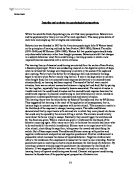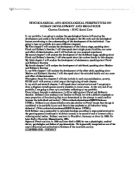Emma Grant
Describe and evaluate two psychological perspectives.
Within the scientific field of psychology you will find many perspectives. Behaviorism and the psychoanalytic theory are two of the most significant. This essay gives details of each view and weighs up their strengths and weaknesses.
Behaviorism was founded in 1913 by the American psychologist John B Watson based on the principles of learning outlined by Ivan Pavlov (1849-1936), Edward Thorndike (1874-1949) and BF Skinner (1904-1990). Watson felt that psychologists should study only observable behaviour rather than thought processes. Behaviourists felt that changes in a subjects behaviour result from conditioning, a learning process in which a new response becomes associated with a certain stimulus.
The learning theory of classical conditioning was started from the works of Ivan Pavlov, a Russian physiologist. Pavlov was conducting research on the digestive system of dogs, when he noticed that the dogs were beginning to salivate at the sound of the cupboard door opening. Pavlov took this further by introducing a bell and eventually the dogs began to salivate when Pavlov merely rang the bell. It was in the dogs nature to salivate when bought food, this is an unconditioned response (salivation) to an unconditioned stimulus (food); no learning had been required. The sound of the bell was a neutral stimulus; there was no natural connection between a ringing bell and food. But by pairing the two together, repeatedly they eventually became associated. The neutral stimulus is transformed into the conditioned stimulus and the unconditioned response becomes the conditioned response. In classical conditioning no new behaviours are learnt, instead an association is developed between an unconditioned and neutral stimulus.
This learning theory was the taken further by Edward Thorndike and later by BF Skinner. They suggested that learning is the result of the application of consequences; that is, learners begin to connect certain responses with certain stimuli. This connection results in the likelihood of the response to change; learning occurs. Thorndike and Skinner demonstrated this by experiments with cats and rats in which they were placed into boxes that could only be opened by the animals hitting a switch. The animals would initially move about the boxes trying to escape. Eventually they would trigger the switches and for this food was given. When a reward was given it reinforced the likelihood of the behavior occurring again. After many more trails in the boxes the animals had learnt what to do and would hit the switch immediately. Skinner went on to experiment with three other stimuli; electrifying the cage floor, taking away the reward and electrifying the switch. Out of these experiments Thorndike and Skinner came up with positive and negative reinforcement and positive and negative punishment. Positive reinforcement is pleasurable which increases the chance of repeated behavior. Negative reinforcement refers to the avoidance of an unpleasant stimulus but the result is also rewarding. Positive punishment such as receiving an electric shock decreases the likelihood of a behavior. By removing a pleasant stimulus negative punishment also decreases the likelihood of a behavior. It was suggested that behavior was learnt through trial and error and the learning theory of operant conditioning was formed. Classical and operant conditioning became the foundations of the psychological perspective of behaviorism.







